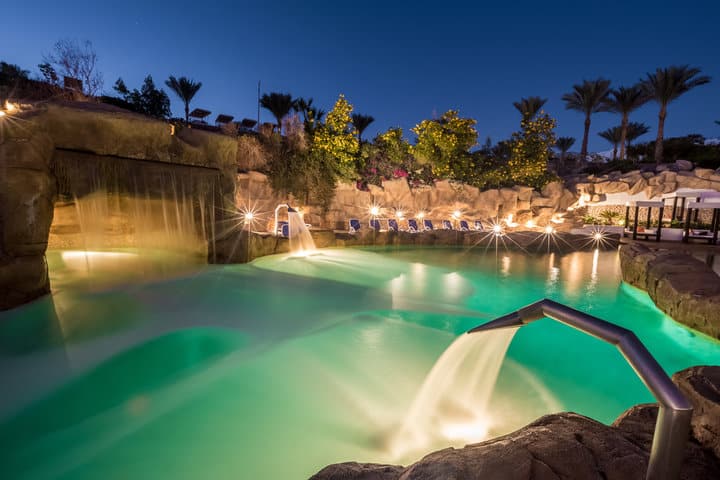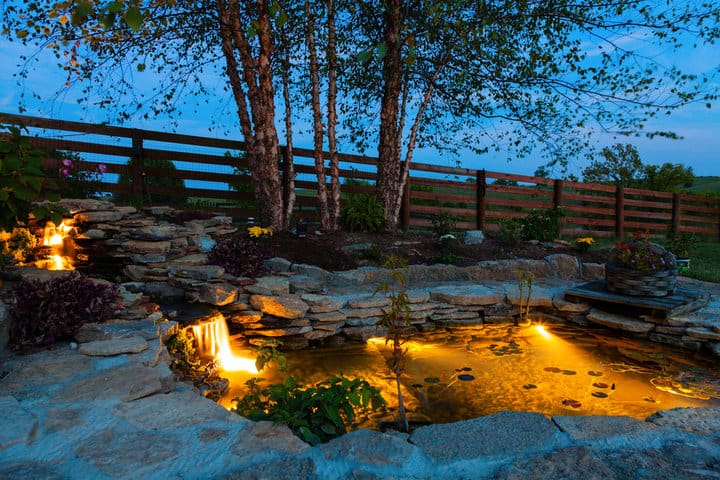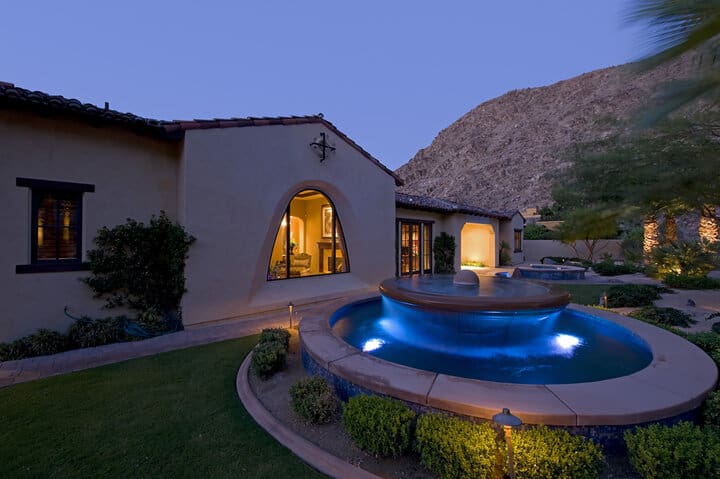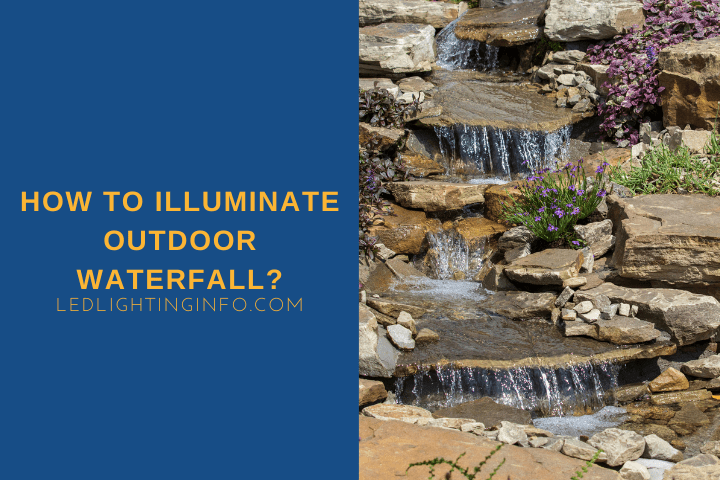While a waterfall is an attractive water feature in its own right, you can bring it to life with lighting.
Waterfalls look best when they have distinction – when you can fully see the effect of the cascading water.
During the day, that’s fine, but at night your standard pool lights won’t do enough to showcase the waterfall itself.
So how do you light up a waterfall properly?
Waterfalls can be illuminated from various angles – underwater lights pointing up best highlight the water flow, uplights above the water level emphasize the feature’s height, and downlights are more subtle. Colored lights are great for highlighting bubbles.
In this guide, I’ll take you through:
- The ideal positioning for waterfall lights
- Some waterfall lighting inspiration
- General tips on illuminating a water feature
What Is The Ideal Positioning For Waterfall Lights?

When you think about lighting a waterfall, you must break it down into different elements.
You can’t think of a waterfall as a single feature because then you’ll try to light the whole thing, and you won’t get a pleasant effect.
It’ll look artificial, and it’ll stand out in the wrong way.
A waterfall consists of three main areas:
- The top, where the water comes over the edge
- The cascading water
- The surface, where the waterfall lands
Where you want to focus your light will depend on the type of waterfall you have. They aren’t all the same!
And you’ll need to consider the type of waterfall you have and where you want to show off.
If your waterfall is a rocky, multi-level feature consisting of several small waterfalls, your priority is not on lighting up the very top but on gently illuminating the various rocks and highlighting the cascading water.
If you have a contemporary waterfall with an almost laminar-flow style sheet of water, you should focus on lighting the top of the waterfall, as this will create a more gentle glow through the sheet of water.
But when we’re talking about positioning, there are three options you can choose from:
- Downlighting the waterfall from above
- Uplighting the waterfall from below, but above the surface
- Submerged lights
Downlighting – positioning lights at the top of the waterfall or above the waterfall shining down – is an excellent way to highlight the water flow and create a glow on the surface.
This is often used with modern waterfalls, with the light running across the length of the top.
Uplighting is better for highlighting both the stream of the water and the surrounding area, so it is often used with rocky waterfalls.
Smaller lights shine up onto the rocky surfaces.
And submerged lighting pointed upwards is better for focusing on the water hitting the surface.
You aren’t limited to just one option – most people recommend choosing either downlighting or uplighting and combining it with submerged lighting. But only if your water is clear.
If you have murky water, underwater lights are pointless as the light will be lost.
You don’t really want to highlight the murkiness anyway. If your pond water isn’t clear, stick to either uplighting or downlighting the waterfall.
How To Highlight Waterfall Air Bubbles?

Depending on the speed of your waterfall, you may have a nice bubbling effect where the water hits the surface. And this can be an excellent place to focus your lighting.
Illuminating a bubbling surface is attractive because it can create a shimmer effect.
The bubbles will refract the lighting, diffusing it to give a gentle glow that will sparkle thanks to the constantly moving surface of the water.
You’ll want to shine a light directly where the waterfall meets the surface to achieve this.
If your pond is clear, do it from below – it’ll also help light up the sub-surface bubbles.
If your pond isn’t clear, or the waterfall is swift and churning the water a lot, use low-level lights above the water level, aimed at a low angle so that they catch the surface where the waterfall meets it.
It’s also a good idea to use colored lights.
Blue or green lights will do better than plain white at accentuating the bubbles in the water, giving them more definition while retaining a sense of natural light.
Waterfall Lighting Inspiration
Here are a few different examples of how you can light your waterfall.
Modern waterfalls
Using downlights from an elevated position that lights up the start of the waterfall will reinforce the contemporary design and create a clear view of the sheets of water and the reflection on the surface.
It’s not just good for those waterfalls that have a sheet of water either – other modern waterfalls with gentle raindrop-effect waterfalls also look good with downlighting.
Meanwhile, if you have more of a rocky effect waterfall, using multiple smaller lights works well for showcasing both the streaming water and the rocky landscape:
But you must ensure you position enough lights to properly showcase the full feature.
If you only use submerged uplighting below the water, you can end up with pockets of light, and the rest of the feature can look a little washed out.
How To Illuminate A Water Feature?

Whether it’s a waterfall or any other water feature, you need to stick to a set of principles when setting up your lighting.
Water features vary wildly, from impressive fountains to gentle trickles, so there aren’t a set of complex rules that work every time.
Instead, once you know your water feature, use these principles to determine what works best for your pond and garden.
Set the mood
Are you looking to showcase an impressive water feature, or do you want to incorporate your water feature into a more serene atmosphere?
If the water feature is a centerpiece – like a fountain – use uplighting to put the focus on it.
If, instead, the feature is part of a wider landscape design, use downlighting to create a soothing, gentle glow that reflects off the water’s surface.
Mix it with some uplighting, particularly with uneven surfaces like a rocky waterfall.
Otherwise, downlighting alone will create dark shadows.
Use enough lighting
This relies heavily on the last point, but you need to use enough lighting – which may be more than expected.
Water – especially moving water – will diffuse light in various directions, including into the air. So your lighting will be less effective.
You may need to use more than you think to create a powerful enough glow to be seen.
But a balance is necessary – too much and you can spoil the mood you were setting.
With that in mind…
Experiment first
Before you commit to a permanent installation, try experimenting with your lights’ position and trying different things.
You can also supplement your lighting with torches to see how more lighting may enhance or detract from your setup.
Even if you think you’ve nailed the theory, try a few different lighting layouts, as you may find an effect you prefer.
With the variance in ponds, water features, and the unpredictability of water, experimentation is always the best way to get your ideal solution.
Consider pond life

If you have plant or animal life in your pond, consider how your lighting will impact them.
This will be more of a consideration regarding how long you leave your lights switched on, but the position is essential, too, especially with fish.
You want to avoid lighting up their hiding spots to protect them from predators.
Be mindful that you should have a mix of light areas and dark spots if you’re adding a water feature.
Especially if it’s a perching spot for a bird that might fancy eating your fish – ensure that there are plenty of darker areas around the rest of the pond where they can shelter.
Maintain your lighting system
Your lighting system, once set up, will generally work fine, but you want to make sure that lights aren’t ‘permanent’ so that you can’t replace them if something goes wrong.
This is especially true with water feature lighting because moving water can cause more problems – it may disturb the lights, or flowing water may cause more wear and degradation on the lights over time.
If you have lights close to moving water, carry out regular maintenance to clean them and check they are working fine, with no signs of damage.
Final Words
I wish there was a simple answer to lighting waterfalls, but that would mean all waterfalls would be the same, and cookie-cutter water features would be dull.
The fact that you could add so many fantastic features to your pond is impressive, and finding the right way to light them may be challenging but worthwhile.
The end results can look incredible.
Have you got a waterfall, and if so, how have you chosen to light it?

